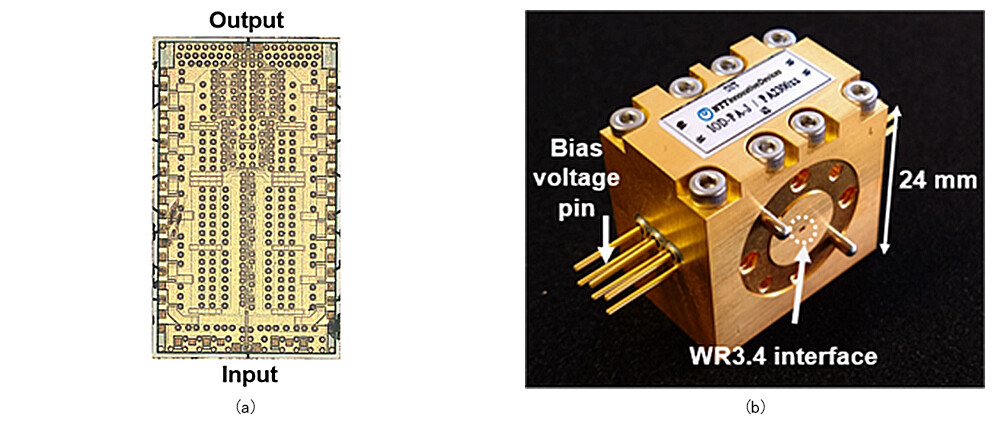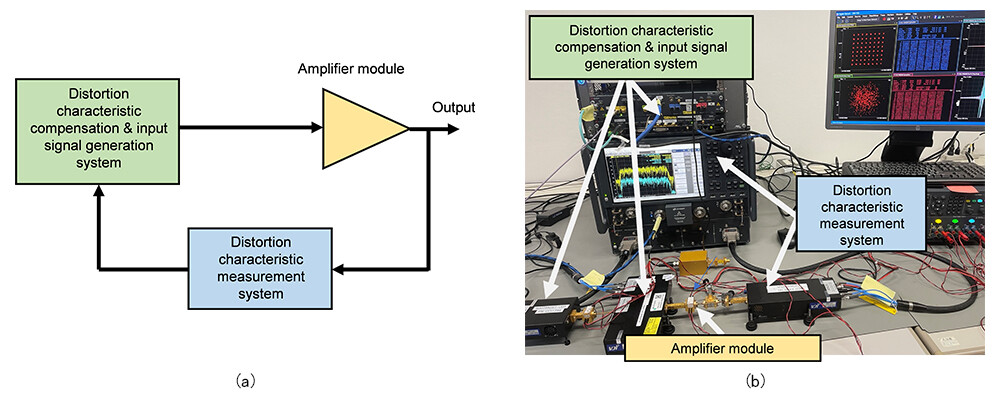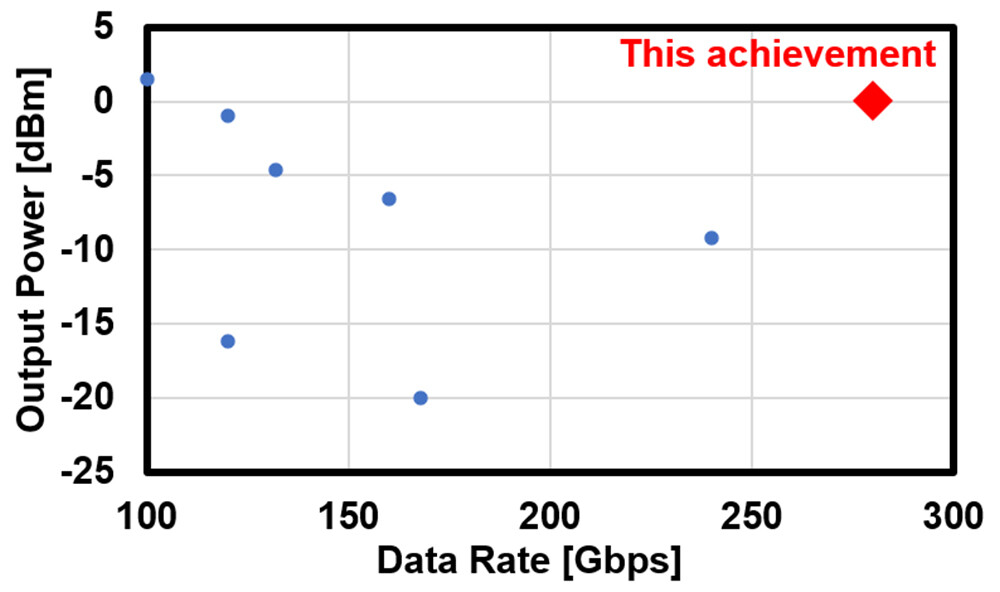Microsoft ends support for Internet Explorer on June 16, 2022.
We recommend using one of the browsers listed below.
- Microsoft Edge(Latest version)
- Mozilla Firefox(Latest version)
- Google Chrome(Latest version)
- Apple Safari(Latest version)
Please contact your browser provider for download and installation instructions.
June 16, 2025
NTT Corporation
NTT Innovative Devices Corporation
Keysight Technologies, Inc.
Realization of a High-Speed, High-Power 300 GHz-Band Signal Generation System to Accelerate 6G Development
World's fastest 280 Gbps high-power signal generation achieved using a wideband amplifier
- Developed a signal generation system combining a wideband 300 GHz amplifier and high-precision distortion compensation technology
- Achieved world-record signal generation at 280 Gbps with an output power of 0 dBm1, approximately 8 times higher than previous systems
- Expected to accelerate industrial applications of sub-terahertz waves through the provision of high-speed, high-power signal generation systems
TOKYO - June 16, 2025 - NTT Corporation (Headquarters: Chiyoda, Tokyo; President and CEO: Akira Shimada; hereinafter "NTT"), NTT Innovative Devices Corporation (Headquarters: Yokohama, Kanagawa Prefecture; President & CEO: Hidehiro Tsukano; hereinafter "NTT Innovative Devices"), and Keysight Technologies, Inc. (Headquarters: Santa Rosa, California, USA; President and CEO: Satish Dhanasekaran; hereinafter "Keysight") have jointly developed a wideband amplifier module that fully covers the J-band (220 GHz to 325 GHz), along with a measurement system capable of precisely compensating for signal distortion. By integrating these technologies, they have successfully generated high-power signals at 0dBm and achieved a world-record data rate of 280 Gbps in the 300 GHz band.
The research result is scheduled to be presented at an international conference IMS2025 (2025 IEEE MTT-S International Microwave Symposium), to be held in San Francisco, USA, starting June 15, 2025.
Background of the Research
In 6G, sub-terahertz waves (radio waves in the 100 GHz to 300 GHz frequency band), which offer access to wide bandwidths, are expected to enable ultra-high-speed wireless communication and high-precision radar sensing. For the research, development, and practical implementation of systems using sub-terahertz waves, system validation and evaluation using modulation signals2 are essential.
In the 300 GHz band—anticipated for use in ultra-high-speed wireless communications exceeding 100 Gbps— WR3.4 waveguide3 in the J-band (220 GHz to 325 GHz) are commonly used as input/output interfaces for measurement equipment. Therefore, in the development of wireless communications and radar systems using the J-band, it is crucial to have a signal generation system that supports the J-band and can generate high-power, high-speed modulated signals.
However, amplifying signals in the J-band is technically demanding, and as the signal speed and power increase, the adverse effects of signal distortion become more significant. These challenges have made it difficult for conventional signal generation systems to achieve both high output power and high modulation speed simultaneously.
Research Achievement
To realize an evaluation signal generation system capable of producing high-speed, high-power modulated signals in the J-band, NTT, NTT Innovative Devices, and Keysight collaborated on the following research and development efforts.
NTT designed and developed a new amplifier integrated circuit (IC) equipped with a wideband impedance matching circuit and a low-loss combiner circuit (Figure 1(a)). This amplifier IC was designed using a high-speed InP-based compound semiconductor4, originally developed by NTT. Thanks to this circuit configuration, low-loss signal combining across the full J-band—previously a major technical challenge—was achieved, enabling high output power across the entire J-band frequency range.
Furthermore, by applying the distortion compensation technology developed by Keysight to the amplifier module jointly developed by NTT and NTT Innovative Devices, a signal generation system was constructed that successfully combines wide bandwidth with high linearity (Figure 2). As a result, high-speed, high-power signal generation was achieved.
NTT Innovative Devices manufactured the amplifier IC designed by NTT using the aforementioned InP-based compound semiconductor. The IC was mounted in a low-loss J-band waveguide package also designed by NTT, resulting in the development of an amplifier module that was provided for this experiment (Figure 1(b)). This amplifier module covers the entire J-band and achieves a maximum output power of +9.1 dBm.
Keysight contributed its proprietary system for measuring signal distortion characteristics (Vector Component Analyzer5) and its high-precision distortion compensation signal processing technology, known as Digital Pre-Distortion (DPD) (Figure 2). This technology measures the distortion generated in the system and pre-corrects the input signal to reduce distortion in the output. In this study, DPD was successfully applied in the 300 GHz band, achieving the world's highest data rate to date in this frequency range.
Through these efforts, the team succeeded in generating a modulated signal at 280 Gbps (35 GBaud6 256-QAM7)—the highest reported data rate in the 300 GHz band (Figure 3). The output power reached 0 dBm, approximately 8 times higher than that of previous records (−9 dBm8), marking a major step forward in generating practical high-power signals (Figure 4).
 Figure 1 (a) Microscope Image of Amplifier IC (b) External View of Amplifier Module
Figure 1 (a) Microscope Image of Amplifier IC (b) External View of Amplifier Module
 Figure 2 Measurement Setup of Signal Generation System Combining Amplifier Module and Distortion Compensation Technology
Figure 2 Measurement Setup of Signal Generation System Combining Amplifier Module and Distortion Compensation Technology
(a) Block diagram (b) Photo
 Figure 3 Constellation of Generated 280 Gbps (35 GBaud 256-QAM) Modulated Signal9
Figure 3 Constellation of Generated 280 Gbps (35 GBaud 256-QAM) Modulated Signal9
 Figure 4 Comparison with Previous Reports on Signal Generation in the J-Band
Figure 4 Comparison with Previous Reports on Signal Generation in the J-Band
Outlook
In the present achievement, signal processing was used to feed back test signals from the output side to the input side in order to compensate for signal distortion. Looking ahead, we plan to explore the application of feedforward distortion compensation using distortion models, which would enable simpler and more flexible signal generation without the need for test signal feedback.
We will also continue to develop and commercialize devices, equipment, and signal processing methods aimed at achieving even higher-speed and higher-power signal generation. Through these efforts, we aim to accelerate research and development of systems utilizing sub-terahertz waves.
Notably, the amplifier module used in this experiment is already being commercialized by NTT Innovative Devices10.
[Glossary]
1dBm
A unit commonly used in radio and fiber-optic communications. Since these systems handle signals with a wide dynamic range of power, dBm expresses power levels relative to 1 milliwatt, using the formula: P(dBm) = 10 × log₁₀(P(mW)).
2Modulation signal
A signal in which information is embedded by converting it into a frequency suitable for transmission over a given communication channel—typically a higher frequency.
3WR3.4 waveguide
A waveguide is a physical structure used to guide electromagnetic waves, especially at high frequencies. WR3.4 is a standardized waveguide type used for the J-band (220 GHz-325 GHz).
4InP (Indium Phosphorus) based compound semiconductor
A type of III-V compound semiconductor composed of indium (In) and phosphorus (P). Compared to silicon (Si), it offers higher electron mobility and enables higher operating frequencies. It is widely used in fiber-optic communications and high-speed electronic devices.
5Vector Component Analyzer
Keysight VNA (Vector Network Analyzer) based solution for component characterization, under modulated signal operating condition.
https://www.keysight.com/us/en/assets/3123-1405/technical-overviews/6G-Vector-Component-Analysis.pdf
6GBaud
A unit representing the number of signal symbols transmitted per second, also known as symbol rate or modulation rate. 1 GBaud = 1,000,000,000 Baud.
7256-QAM
Quadrature Amplitude Modulation (QAM) is a digital modulation method that conveys information by varying both amplitude and phase. 256-QAM modulates the signal into 256 distinct symbol points, enabling high data density.
8Reference
Keisuke Maekawa, Tomoya Nakashita, Toki Yoshioka, Takashi Hori, Antoine Rolland, Tadao Nagatsuma, "Single-channel 240-Gbit/s sub-THz wireless communications using ultralow phase noise receiver," Electronics Exp., vol. 21, no.3, pp. 20230584, 2024..
9Constellations
A visual representation of different signal states in digital communication. Each symbol is plotted as a point on a two-dimensional plane defined by in-phase and quadrature components, illustrating both amplitude and phase characteristics.
10Amplifier module
https://www.ntt-innovative-devices.com/en/sensing_application/thz_products.html#j-band-power-amplifier
About NTT
NTT contributes to a sustainable society through the power of innovation. We are a leading global technology company providing services to consumers and businesses as a mobile operator, infrastructure, networks, applications, and consulting provider. Our offerings include digital business consulting, managed application services, workplace and cloud solutions, data center and edge computing, all supported by our deep global industry expertise. We are over $92B in revenue and 330,000 employees, with $3.6B in annual R&D investments. Our operations span across 80+ countries and regions, allowing us to serve clients in over 190 of them. We serve over 75% of Fortune Global 100 companies, thousands of other enterprise and government clients and millions of consumers.
Media contacts
NTT Science and Core Technology Laboratory Group
Public Relations
Inquiry Form
Information is current as of the date of issue of the individual press release.
Please be advised that information may be outdated after that point.
NTT STORY
WEB media that thinks about the future with NTT










